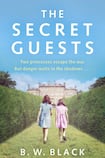
BW Black is a variant of John Banville’s pseudonym Benjamin Black. The “BW” may be an allusion to Banville’s actual first name, William, but whatever the reason, it is typical of the kind of nameplay that has been a feature of his fiction. Banville has had a long fascination with individuals who conceal their true selves by adopting multiple identities, with mask-wearers, frauds and tricksters, such figures who more often than not are also types of artists.
But what does this new pseudonym signify? Just as “John Banville” may be associated with high-brow literary fiction, so “Benjamin Black” is a crime writer. The Secret Guests, a sort of speculative historical fiction that contains elements of the Irish Big House novel and the high-stakes thriller, sits perhaps somewhere between a John Banville and a Benjamin Black novel.
Set in 1940, the Princesses Elizabeth and Margaret are whisked for their safety out of Blitz-time London to Clonmillis Hall, a declining Big House in rural Tipperary (the title of the novel recalls Frank O’Connor’s “Guests of the Nation”). Under the care of a MI5 agent posing as their governess, Celia Nashe, the girls are renamed Ellen and Mary to hide their identity. The arrangement is agreed between the uncouth Irish Minister for External Affairs, ex-West Cork IRA-man Dan Hegarty, and the suave English diplomat Richard Lascelles. Nashe’s Irish counterpart is the Protestant detective Garda Strafford, the novel’s most rounded character, and together they are assigned to guard the princesses.
Second World War
Many stock characters of the Irish Big House assemble in Clonmillis Hall. There is the heir to Clonmillis, the perpetually cranky Duke of Edenmore (a partial anagram of Ormonde), his staff of gossipy maids and housekeepers, and two warring groundsmen, the hideously ugly one-eyed Pike and the brooding, mysterious Billy Denton, who provides the flighty Princess Margaret with her first crush. Éamon de Valera’s son Vivion, who rose to the rank of major in the Free State Army, pops up implausibly but hilariously to guard the royal guests. Then there are local IRA – a ragtag troupe of posturing amateurs – and their more sinister, violent and business-like Belfast superiors. The novel’s action is largely driven by the national, cultural and class conflicts between these characters, and their various efforts to either protect or capture the largely unaware princesses.
As a nod to “The Emergency”, the war barely registers in the novel and merely serves as device to plant Elizabeth and Margaret in the Irish milieu. The political skirmishes between Free State Ireland and England are not the real battle here either, though there is plenty of mutual antagonism and attraction between the Irish and English characters, who represent various elements in that complicated relationship. Rather the combat is between the various historical and post-Independence loyalties within Ireland, where the enduring presence of the English, and Englishness, is the principal factor. Strafford, for instance, not only knows he is perceived by his Catholic bosses as an outsider, but is also reminded of it by Hegarty.
To underscore the point, Strafford turns out to be an Anglo-Irish intellectual at heart who, in spite of working for the State, also appears at odds with the relative cultural stagnation of the Free State in the post-revolutionary years. He is a discerning reader, seeking out in the local library a novel by DH Lawrence – banned under the censorship regime – and then, because nothing much happens on the Clonmillis estate, devouring a biography of Nero and The Waning of the Middle Ages by Johan Huizinga. He knows his art, noting that one of the house maids “might have been a figure out of Millais”.
Humour
His constantly mispronounced name, which generates much humour in the novel, also points to a much longer decline of the colonial class in Ireland. The First Earl of Strafford, Thomas Wentworth, was appointed Lord Deputy of Ireland in 1632. Strafford, however, is not a self-pitying aristocratic aesthete pining for old colonial glory; he is in some ways a much more interesting character because he has “reconciled himself”; he is a willing functionary of the new Catholic, Gaelic State, who never really thinks about his identity unless reminded of it.
There is much that is familiarly Banvillian about The Secret Guests. Over his career, Banville has returned time and again to the eternally-fading grandeur of the Anglo-Irish Big House with its token cast of comic eccentrics and haunted secret-keepers, from earlier novels such as Birchwood, The Newton Letter and Mefisto through to more recent works such as The Infinities and The Blue Guitar. He explored fraught Anglo-Irish relations and the complexity of identity in these islands in the spy thriller, The Untouchable. There is also something timely about this particular mixture of fact and fiction in The Secret Guests, given how the changing political relationships between Ireland and Britain and the current decade of commemorations are compelling a re-examination of Irish and British history.
And yet, for all that, the author has great fun here. The Secret Guests is a brilliantly entertaining, conceptually inventive, and frequently funny novel that combines Banville's stylistic virtuosity with the excitement of a well-plotted thriller. If the first half of the novel is all atmosphere and intrigue, the second half of the book is action and adventure. The chapters are short and punchy, the writing typically deft, and the drama rapidly accelerates towards its inevitable denouement. If The Secret Guests is a sign of things to come from BW Black, then there is much to anticipate.
Eoghan Smith is the author of the novel The Failing Heart (2018) and the monograph John Banville: Art and Authenticity (2013). He co-edited with Simon Workman the collection of essays Imagining Irish Suburbia in Literature and Culture (2018).












